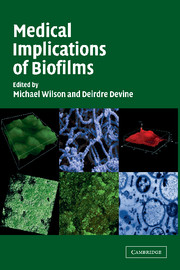Book contents
- Frontmatter
- Contents
- Preface
- List of Contributors
- PART ONE INTRODUCTORY CHAPTERS
- PART TWO BIOFILMS ON PROSTHETIC DEVICES
- PART THREE ORAL BIOFILMS
- 8 Novel Microscopic Methods to Study the Structure and Metabolism of Oral Biofilms
- 9 Oral Streptococcal Genes That Encode Biofilm Formation
- 10 Gene Expression in Oral Biofilms
- PART FOUR BIOFILMS ON SHEDDING SURFACES
- Index
- References
10 - Gene Expression in Oral Biofilms
Published online by Cambridge University Press: 23 November 2009
- Frontmatter
- Contents
- Preface
- List of Contributors
- PART ONE INTRODUCTORY CHAPTERS
- PART TWO BIOFILMS ON PROSTHETIC DEVICES
- PART THREE ORAL BIOFILMS
- 8 Novel Microscopic Methods to Study the Structure and Metabolism of Oral Biofilms
- 9 Oral Streptococcal Genes That Encode Biofilm Formation
- 10 Gene Expression in Oral Biofilms
- PART FOUR BIOFILMS ON SHEDDING SURFACES
- Index
- References
Summary
INTRODUCTION
The only natural habitat for the aetiological agents of dental caries and periodontal diseases, as well as the overwhelming majority of oral bacteria, is the mouth. These organisms exist almost exclusively as constituents of the biofilms that form on the soft and hard tissues of the oral cavity and, therefore, can be thought of as ‘obligate biofilm organisms’ (Burne, 1998a). Bacteria capable of sustaining a free-living existence have sensing and differentiation systems that allow the organisms to detect acquisition of a suitable host, to alter motility and capsule expression, and to transition from oligotrophic systems to relatively nutrient-rich systems where they must confront the innate and acquired defences of a host. In contrast, oral bacteria do not have to transition between radically different environments, such as moving from the gut of a mammal to a mountain stream or decaying forest material and vice versa. Therefore, it is reasonable to predict that, through normal evolutionary processes, oral biofilm bacteria may have sloughed off many of the elaborate genetic systems for responding to the transition from the free-living state to the host-associated or biofilm state. In fact, with the completion or near completion of a number of genomes of oral bacteria, it is clear that oral bacteria have comparatively small chromosomes and lack many of the sensing and differentiation pathways that are present in organisms that can exist in a free-living state, such as Pseudomonas aeruginosa, Escherichia coli, and Yersinia pestis.
- Type
- Chapter
- Information
- Medical Implications of Biofilms , pp. 212 - 228Publisher: Cambridge University PressPrint publication year: 2003
References
- 1
- Cited by



